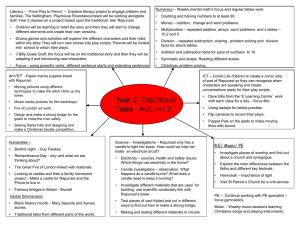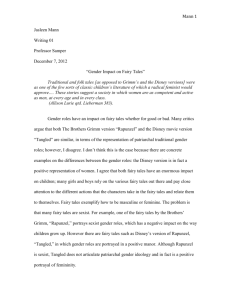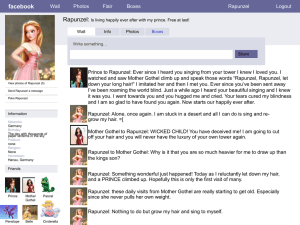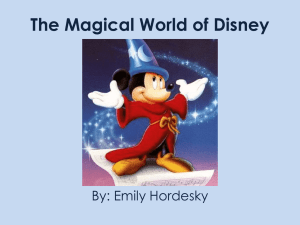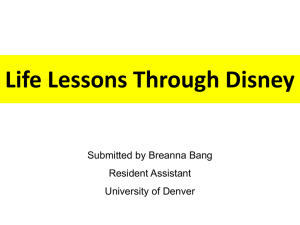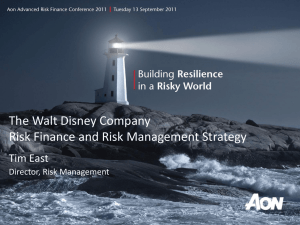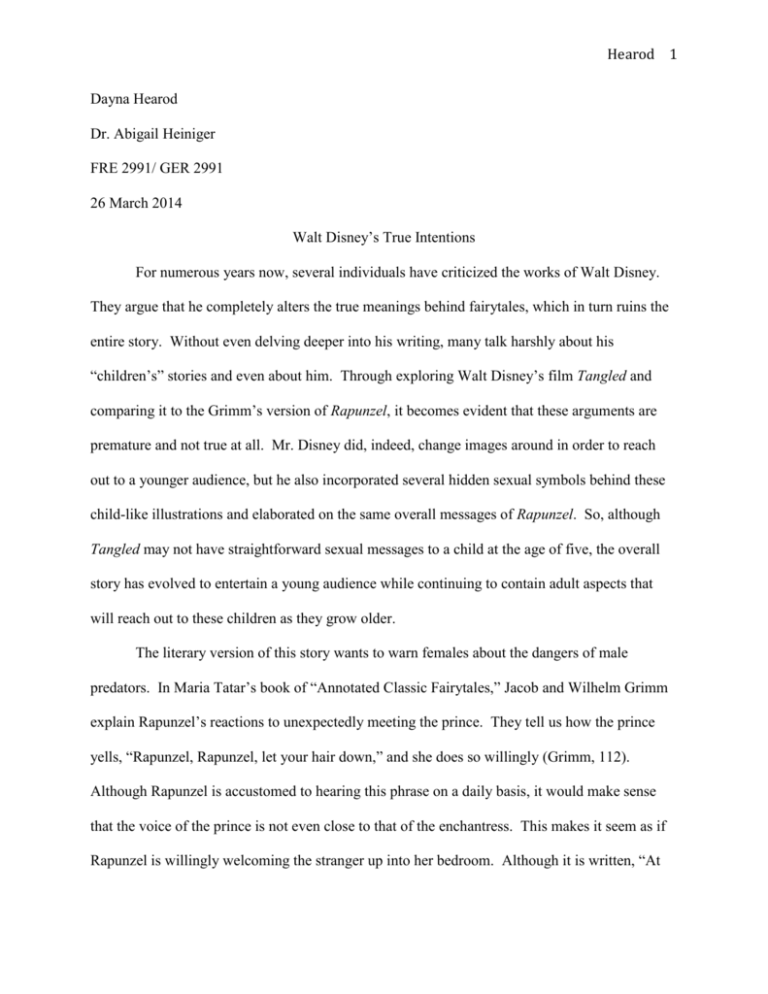
Hearod 1
Dayna Hearod
Dr. Abigail Heiniger
FRE 2991/ GER 2991
26 March 2014
Walt Disney’s True Intentions
For numerous years now, several individuals have criticized the works of Walt Disney.
They argue that he completely alters the true meanings behind fairytales, which in turn ruins the
entire story. Without even delving deeper into his writing, many talk harshly about his
“children’s” stories and even about him. Through exploring Walt Disney’s film Tangled and
comparing it to the Grimm’s version of Rapunzel, it becomes evident that these arguments are
premature and not true at all. Mr. Disney did, indeed, change images around in order to reach
out to a younger audience, but he also incorporated several hidden sexual symbols behind these
child-like illustrations and elaborated on the same overall messages of Rapunzel. So, although
Tangled may not have straightforward sexual messages to a child at the age of five, the overall
story has evolved to entertain a young audience while continuing to contain adult aspects that
will reach out to these children as they grow older.
The literary version of this story wants to warn females about the dangers of male
predators. In Maria Tatar’s book of “Annotated Classic Fairytales,” Jacob and Wilhelm Grimm
explain Rapunzel’s reactions to unexpectedly meeting the prince. They tell us how the prince
yells, “Rapunzel, Rapunzel, let your hair down,” and she does so willingly (Grimm, 112).
Although Rapunzel is accustomed to hearing this phrase on a daily basis, it would make sense
that the voice of the prince is not even close to that of the enchantress. This makes it seem as if
Rapunzel is willingly welcoming the stranger up into her bedroom. Although it is written, “At
Hearod 2
first, Rapunzel was terrified,” it only makes sense to assume that she knew better than to let her
hair down in order to welcome a strange man into her bedroom (Grimm, 112). If one thinks
about it, this is extremely realistic. The story is attempting to warn girls about the dangers of
male predators. When it comes to men, girls tend to disregard the fact that there are dangerous
ones out there. When a male shows some sort of interest in a female, the female generally takes
full advantage of the situation and welcomes him in regardless of the fact that she may not know
a single thing about him. The Grimm brothers are trying to warn girls about the dangers of male
predators because they know that many girls tend to be naïve to what could really happen.
When Walt Disney’s version of “Rapunzel,” Tangled, was released, the imagery changed
quite a bit in order to make the film more entertaining for children; however, the overall
intentions for developing this story did not. One example is the way that the Prince enters the
tower. Unlike the written version, Tangled shows the prince climbing up the large wall on his
own so that he could enter into the tower (Tangled). This is definitely much less welcoming than
throwing her hair down for assistance when a man asks her to do so. Disney makes it seem as if
the prince is trespassing into the tower or breaking in as opposed to being welcomed. In addition
to this, Rapunzel also has on a light purple dress and looks to be nearly fifteen years old, while
Flynn Rider has a well-developed upper body and facial hair, and looks to be close to 30
(Tangled). Through pairing this young girl with an older looking man (one that broke into her
tower on top of that), Walt Disney continues to elaborate on the dangers of male predators, even
more so than the Grimm brothers. Not only is Rapunzel looking young and wearing child-like
colors, she is also very clearly frightened by the presence of the prince. When he enters the
castle, she hits him in the head with an iron skillet, knocking him unconscious, and she won’t
even approach him without hiding behind a tall object (Tangled). Her body language and visible
Hearod 3
reactions leave no doubt that Rapunzel is actually afraid of this man, and definitely has no
intentions of performing any sexual acts with him, unlike the story depicted by the written
version.
One scholar to consider while studying the evolution from Rapunzel to Tangled is
Frances Clarke Sayers. She makes an argument bashing Walt Disney for manipulating the entire
story. Sayers says that by doing this, Mr. Disney is being disrespectful to “the integrity of the
original creations of authors” (Sayers). Through looking at the example given above, it is
obvious that this is not the case at all. In fact, I would argue that Walt Disney did the exact
opposite by changing the fairytale around. He may have changed the way images were depicted
in order to entertain a younger audience, but he also brought forth an identical overall message
so that older children and adults would learn from the film as well. He did not completely
change the tale around and make it his own; he used ideas from other scholars in order to reach
out to a wide variety of audiences instead of relaying an important message to growing children
but making the story clearly explicit. If anything, Walt Disney enhanced the original story of
Rapunzel by having Flynn Rider break in. When a girl welcomes a man in, it no longer makes
that man seem like a predator, but a friend instead. When girls hear that Rapunzel let her hair
down willingly to assist the prince into her tower, they don’t assume that he represents someone
that could potentially hurt the princess. On the other hand, when Flynn Rider, in Tangled, climbs
up the tower and enters, uninvited may I add, the initial message about male predators becomes
evident. The children watching the film automatically see a man that looks to be twice
Rapunzel’s age entering into the tower without knocking, asking, or even being invited. When
we think of predators, that is how they are. They don’t ask us to help them into our home; they
do so without an invitation, which is exactly how Walt Disney portrayed the message.
Hearod 4
It is definitely possible to make an argument in support of Disney’s Tangled (2010), but
consider looking at the entire plot/interactions between Rapunzel and Flynn, not just the initial
scene. You might argue that the initial scene enhance the predatory nature of Rapunzel’s first
encounter with a man, but then what do we make of the conclusion? “Don’t worry kids, the
creepy guy breaking into your bedroom is there to help you, and in the end he will save your life.
Forget your parents and run away with him!” The end still resonates with the celebration of
sexual choice and freedom (Rapunzel rewarded with the prince despite pre-marital sex – that
never happens in revised fairy tales, but it does here). This was meant to encourage French
women to rebel against arranged marriages and find love (and sexual fulfillment). Disney can’t
quite escape that message, and perhaps they make it more “tangled” by making Flynn a predator
who turns out to be good. Just something to think about.
Works Cited
Grimm, Jacob, and Wilhelm Grimm. "Rapunzel." The Annotated Classic Fairy Tales. New
York: Norton, 2002. 112. Print.
Sayers, Frances Clarke. "Walt Disney Accused." Horn Book 40 (Dec. 1965): 1 602-11. Rpt. in
Children and Literature: Views and Reviews. Ed. Virginia Haviland. Glenview, IL:
Scott, Foresman and Company, 1973. 116-25.
Tangled. Dir. Nathan Greno and Byron Howard. Perf. Mandy Moore and Zachary Levi.
WaltDisney, 2010.

